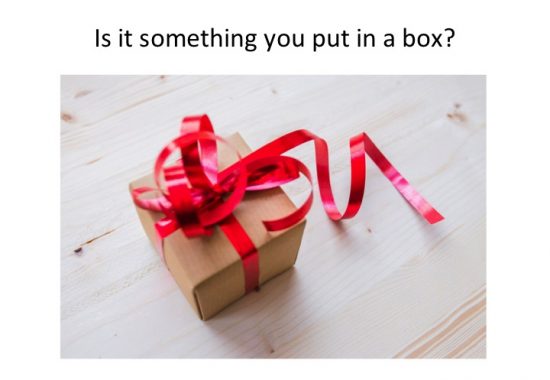Holidays, like Valentine’s Day today, present a great opportunity for group conversation about plans, traditions, and gift giving. In some groups, all the clinician needs to do is ask, “What are your plans for Valentine’s Day?”, and that’s the last thing she says for the rest of the hour! People debate the value of the “hallmark holiday”, exchange jokes about what they didn’t buy their spouses, or enthusiastically share their elaborate plans.
Other groups, however, might need more support. In some cases because members have more difficulty communicating. In others, because they are just generally more reticent. One way to get things going is to engage the group members in asking each other questions. Particularly for members with more severe production difficulties, it may be that they spend more time as the recipients of questions, and have fewer opportunities to elicit information from others.
A twist on barrier or grab-bag activities is a great way to go, especially when you have a theme like a holiday to work with. It starts out in the typical way, group members take turns choosing a secret gift idea out of the bag. But, rather than that group member providing clues, everyone else must figure out a way to elicit useful information from the bearer of the secret gift.
For group members with less difficulty communicating, activities could include:
- Playing 20 questions! Have the group members determine the rules and see how strategic they can be in their questioning.
- Seeding the grab bag with gifts that are silly (e.g., toaster) or outrageous (e.g., trip to Paris), so they’re less obvious, and more fun, to guess.
- Playing Taboo-style, wherein the member answering the questions is not allowed to use the five taboo (i.e., most relevant) words when answering questions about their secret gift. For example, if their secret gift is ROSES, they’re not allowed to say THORNS, RED, BOUQUET, VASE, or FLOWER.
For group members with more difficulty communicating, activities could include:
- Setting the gift objects (or photos) out onto the table for everyone to see before they go into the grab bag. Using a ‘closed-set’ will help to guide the members’ questions. You can scaffold this further by including more or fewer potential ‘gifts’, as a larger set will provide more variety, hence more of a challenge. No matter what, be sure to include the toaster and the trip to Paris!
- Taking the first turn yourself, so the members have a model.
- Using photo-cards that provide relevant questions.


 Whatever you do, just make sure to have fun!
Whatever you do, just make sure to have fun!
For more information, see our website or contact Sharon Antonucci at antonucs@einstein.edu.


2 comment on “Activities for aphasia groups (vol. 2): Conversation catalysts”